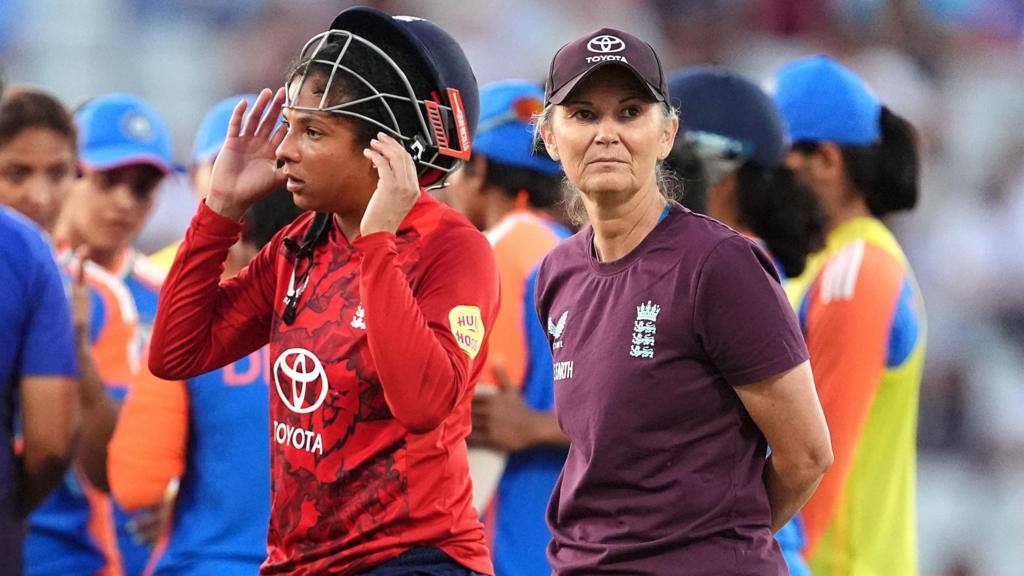This video can not be played
‘Horror’ drop, ‘extraordinary’ dismissal, ‘ridiculous’ catch – England win on final ball
It was unlikely that stakeholders invested in England’s post-Ashes revitalization – encompassing players, supporters, and media – anticipated a seamless transition.
While a 3-2 series loss might not appear devastating, England’s inaugural T20 series defeat on home soil against India has presented Charlotte Edwards and her team with a sobering reality check.
India’s three victories were unequivocally dominant, achieved by margins of 97 runs, 24 runs, and six wickets, respectively.
Conversely, both of England’s wins were tense affairs, secured on the final ball after nearly relinquishing advantageous positions.
An admirable fightback at The Oval in the third match kept the series alive. However, the win at Edgbaston in the fifth proved largely symbolic, as the series had already been conceded. Once again, their performance peaked when the stakes were relatively low.
With the 50-over World Cup looming in India at the end of September, Edwards has frequently referenced England’s “journey” toward the home T20 tournament next year, particularly in the shorter format.
“We’ve still got a long way to go, I’m under no illusions about that,” Edwards stated after England’s thrilling win at Edgbaston, while also confidently challenging critics.
“People have just got to be patient. And certainly in this format, we’ve got 12 months. You can judge us, come next July.”
England stutter to consolation T20 win over India
Filer determined to show women can bowl at 80mph
Another recurring theme from Edwards has been that England is a “team in transition.”
Frankly, this justification is wearing thin.
While new leadership is in place, with Edwards striving to instill greater strategic acumen after a period under Jon Lewis, whose “inspire and entertain” ethos led to a lack of clarity, the core issue remains.
The absence of world-class players like Nat Sciver-Brunt and Heather Knight due to injury would undoubtedly create a significant void in any team. England’s struggle to compensate for their absence is understandable.
However, this is a highly experienced side. The team has benefited significantly from the increased professionalization of women’s cricket globally, with the majority of players having participated in franchise leagues worldwide.
Nine of the eleven players who competed in the final T20 against Australia in January also featured in this series against India – and that figure would be ten if Knight were fit and in the lineup.
The average age of England’s squad is 27.6, compared to India’s 25, and their players average 63.9 international caps each, compared to India’s 56.3.
Following the Ashes, England faced a challenge in terms of fan perception, and Edwards’ candid acknowledgement of the task ahead is likely to be welcomed. However, they are neither an inexperienced nor a youthful team.
The more pressing issue is the limited time available to rectify these problems collectively. A tri-series in May next year, involving India and New Zealand, represents the only international T20s scheduled between now and the World Cup.
Discussions surrounding England’s vulnerability against spin bowling are becoming repetitive.
However, it remains their most critical weakness.
In 2022, England averaged 42.3 against spin in T20s, losing 25 wickets.
The following year, they lost 46 wickets at an average of 18, and so far in 2025, they have lost 41 at 19.9.
Their strategy against slow bowling appears indecisive, oscillating between attack and defense, with batters frequently trapped on the crease or dismissed attempting aggressive shots.
While the upcoming World Cup is in the longer format, England’s opponents will already have formulated their bowling strategies, given the predictability of their weakness.
Edwards has also acknowledged England’s significant need for fielding improvement, an area where they have struggled against India, with frequent misfields and four dropped catches in the final five overs alone during the third match at The Oval.
“It’s a mindset thing under pressure, but it’s an area we work really, really hard on,” said Edwards.
“We are not going to hide away from that.”
In contrast, India’s fielding has improved dramatically. They have consistently prevented twos by charging in from the boundary, made impressive catches near the ropes after covering significant ground, and executed some remarkable dismissals.
At Edgbaston, this was exemplified by Em Arlott and Sophie Ecclestone backing away from catches on the boundary, allowing the ball to bounce in front of them and prioritizing run prevention.
Radha Yadav, meanwhile, sprinted and dove full-stretch to dismiss Amy Jones in spectacular fashion, even when the game was largely in England’s control.
Edwards and numerous players have cited India’s significant improvement, largely attributed to the Women’s Premier League, which has been established for three years, and the experience of playing regularly in front of large crowds where every game carries substantial weight.
While The Hundred offers a similar experience for England, they cannot continue to use the lack of pressure as an excuse, particularly when it doesn’t seem to be a factor for Australia in international cricket. Australia maintains a relentless approach, regardless of the opponent, and India is following a similar path.
This scrutiny will persist for England until they secure a trophy or an Ashes series victory.
Therefore, they will indeed be judged come next July.
Get cricket news sent straight to your phone

